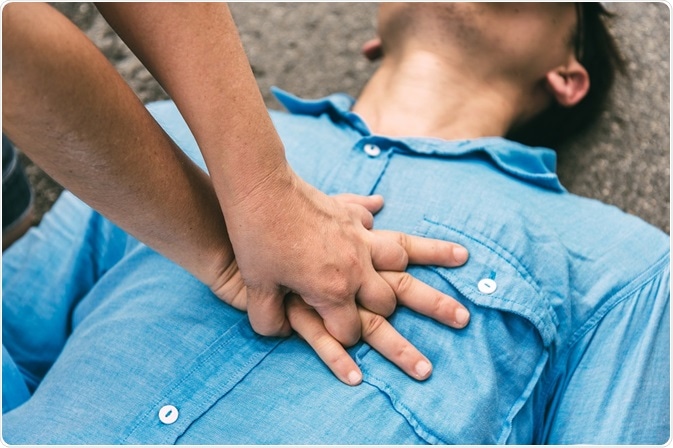Cardiopulmonary resuscitation (CPR) is a lifesaving technique that combines chest compressions and artificial ventilation to maintain oxygenation and circulatory flow during cardiac arrest.

Credit: spkphotostock/Shutterstock.com
What is cardiac arrest?
The heart has an internal electrical system that controls the rhythm of the heart. A problem in this system may cause a cardiac arrest. It may cause the heart to stop pumping blood to the brain and other parts of the body.
When the heart stops pumping blood, the brain does not receive adequate amount of oxygen to function. A person who suffers a cardiac arrest becomes unconscious and stops breathing. A cardiac arrest usually has no symptoms, but without immediate treatment, it can be fatal.
The most common causes of cardiac arrest include coronary heart disease, heart attack, and heart conduction disorders, among others. The other causes include severe hemorrhage, near-drowning, drug overdose, electrocution, and suffocation.
During a cardiac arrest, it is vital to maintain the blood supply to the brain. If CPR is not initiated in time, the person might die within a few minutes.
What is cardiopulmonary resuscitation (CPR)?
CPR is an emergency technique that combines the use of chest compressions and artificial ventilation to maintain blood supply to the brain. It helps sustain intact brain function until further treatment is done.
CPR is performed in emergency conditions such as a heart attack, cardiac arrest, poisoning, electrocution injuries, accidents, suffocation, and near-drowning, among others. CPR is a vital technique to maintain a steady supply of blood and oxygen to the brain when a person is not breathing or circulating blood adequately.
How to perform CPR on an infant or child
Before giving CPR to an unconscious infant or child, you need to check the scene and the patient. Make sure that the surrounding is safe. Then perform the following CPR steps:
- Tap the person and shout, “Are you okay?”. For babies, you can check for a response by flicking of the bottom of the foot.
- Shout for help or call the emergency hotline.
- Open the infant or child’s airway. Let the baby or child lie on the back and tilt the head back. Lift the chin.
- Check for their breathing. Listen for a few seconds (not more than ten seconds) for breathing. However, infants may have periodic breathing, so some changes in their breathing are normal.
- Give two rescue breaths if the baby or child is not breathing. Pinch the child’s nose and create a seal by putting your mouth over the child’s mouth. Breathe into their mouth twice.
- For babies, you can give two rescue breaths by using your mouth to create a seal over the baby’s mouth and nose. Blow in for one second to check if the chest will rise and there’s no obstruction. Deliver two rescue breaths.
- If the baby or child remains unconscious and does not respond to the rescue breaths, begin CPR.
- Kneel beside the baby or child and prepare to give chest compressions.
- For infants, use two to three fingers to give 30 quick compressions at about 1.5 inches deep. In children, put one hand in the middle of the chest and lay the heel of the other hand on top. Lace the fingers together. Like in babies, give 30 quick chest compressions at about 2 inches deep.
- Give two rescue breaths after a set of chest compressions.
- Continue until the baby or child shows signs of life such as breathing. You can also stop if a trained responder has arrived or an AED is ready to use.
First Aid - How to Perform CPR on a Baby I This Morning
How to perform CPR on an adult
Just like in children, you need to check the scene first before performing CPR on an unconscious adult. Here are the steps in performing CPR on an adult patient:
- Gently shake the patient’s shoulders and ask, “Are you okay?” to check for response.
- Ask for help if someone is around to call for an ambulance or an emergency responder.
- The patient should be lying on his or her back. Open the airway by tilting the head back a little and lifting the chin.
- Listen to the patient’s breathing for not more than 10 seconds. If the person is not breathing, start CPR.
- To begin chest compressions, put your hands in the middle of the chest (one on top of the other). Use your body’s weight to give compressions, which are at least 2 inches deep. Push hard and fast with a rate of at least 100 compressions per minute. Provide 30 compressions.
- Tilt the patient’s head back slightly and lift the chin. Pinch the nose and create a complete seal by putting your mouth on the patient’s mouth. Blow into their mouth and observe if the chest rises. Provide two rescue breaths.
- Keep performing cycles of chest compressions and rescue breaths until the person starts breathing, or an experienced responder has arrived and an AED is available.
- In some cases, you can end the cycles of CPR when the environment becomes unsafe and you are too exhausted to continue.
First Aid - How to Perform CPR on an Adult I This Morning
Cardiopulmonary resuscitation (CPR) is a vital skill that everyone should know. Training for CPR and basic life support (BLS) are available worldwide. Learning it saves lives.
Further Reading